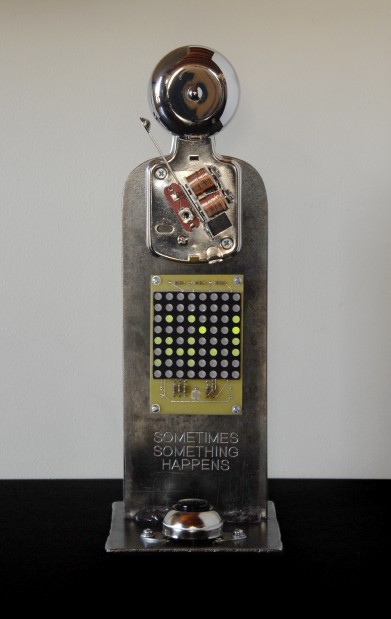This is a simple model of scientific experiment comprising a push-button,
an 8x8 matrix of flashy-LEDs, and a bell/buzzer.
As with any experiment, you poke at something
that (should be) completely mechanistic and try to determine
how it works from the results.
But your poking slightly changes the thing itself.
When SSH is turned on it randomly selects a set of
Cellular Automata (CA)
*
rules, one for each of it's 64 LEDs, and runs a single cycle (8 rows) of
the program. This results in one of three actions on the part of the bell:
Ring, Buzz, or Nothing. Ring happens when more than five of the top row of
LEDs are ON, Buzz with less than four, and Nothing in between. It is a
simple model of a deterministic 'reality' that changes with every power
cycle.
The real fun happens when someone pushes the button. This starts the
CA running from the point where it left off -- with the last row's
data feeding back as input to the first row. The exact moment that the
button is pushed, relative to SSH's internal clock, selects the
number of times it will cycle; and, if the button is still depressed
through a full cycle, the new input data is slightly modified on that pass.
This gives the viewer some indirect control over the results.
Each time the button is released, a random bit in the 512 bits of CA
rules is inverted. Thus the operation of the system changes over time.
SSH is a direct response to the
Vienna Circle's Logical Positivism and the
subsequent rejection of the Enlightenment by the Frankfurt School...
*
Cellular Automata
are a particular form of 'game'
where each element, or cell, (represented by an LED here in SSH)
turns on and off based on the three cells in the row
just below it. Each cell has a rule which specifies the
result of all the possible combinations. When running,
the results are completely pre-determined by the rules
and the initial state of the first set of LEDs, but
it is impossible to know that result without letting
the machine run -- any sort of model or simulation
boils down to just running the automata.

